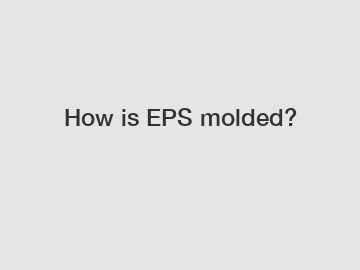Jan. 16, 2024
Agriculture
How is EPS molded?
Expanded Polystyrene (EPS) is a versatile and widely used material that is molded into various shapes for a wide range of applications. The process of molding EPS involves several stages and requires specialized machinery and expertise.
To mold EPS, the first step is to prepare the raw material. Polystyrene beads are pre-expanded using steam, which causes the beads to expand and become lighter. These pre-expanded beads are then sieved to remove any smaller or irregularly shaped beads.

Once the pre-expanded beads are ready, they are placed in a mold. The mold consists of two halves that fit together, forming the desired shape of the final product. The mold is typically made of aluminum or steel and is designed to withstand the heat and pressure of the molding process.
Next, the mold is closed, and steam is injected into the mold cavity. The steam causes the beads to further expand and fuse together. As a result, the mold cavity is filled with expanded polystyrene, taking the shape of the mold.
Once the mold is filled, the steam is released, and the mold is cooled rapidly using either cool air or water. The rapid cooling solidifies the expanded polystyrene, ensuring that it retains the shape of the mold.
After the cooling process, the mold is opened, and the solidified EPS product is removed. Any excess material is trimmed off, and the final product is inspected for quality control.
The process of molding EPS is highly efficient and cost-effective. It allows for the production of complex shapes with a high level of accuracy and consistency. Furthermore, the lightweight nature of EPS makes it ideal for applications where weight reduction is a priority, such as packaging, insulation, and construction.
EPS molding also offers several environmental benefits. EPS is 100% recyclable and can be reused in the production of new EPS products. The low weight of EPS reduces transportation costs and energy consumption. Additionally, EPS has excellent thermal insulation properties, which can contribute to energy savings and reduce greenhouse gas emissions.
In conclusion, EPS is molded through a process that involves pre-expanding polystyrene beads, filling a mold with the expanded beads, and cooling the mold to solidify the EPS into the desired shape. The molding process is efficient, cost-effective, and environmentally friendly. EPS's versatility and beneficial properties make it a popular choice for various applications across industries.
Are you interested in learning more about EPS Forming Machine, Complete equipment for lost foam casting, What is the difference between lost foam casting and solid casting? Contact us today to secure an expert consultation!
Previous: What is the difference between controlled release and slow-release fertilizer?
Next: What are the advantages of biomedia for B2B purchases?
If you are interested in sending in a Guest Blogger Submission,welcome to write for us!
All Comments ( 0 )